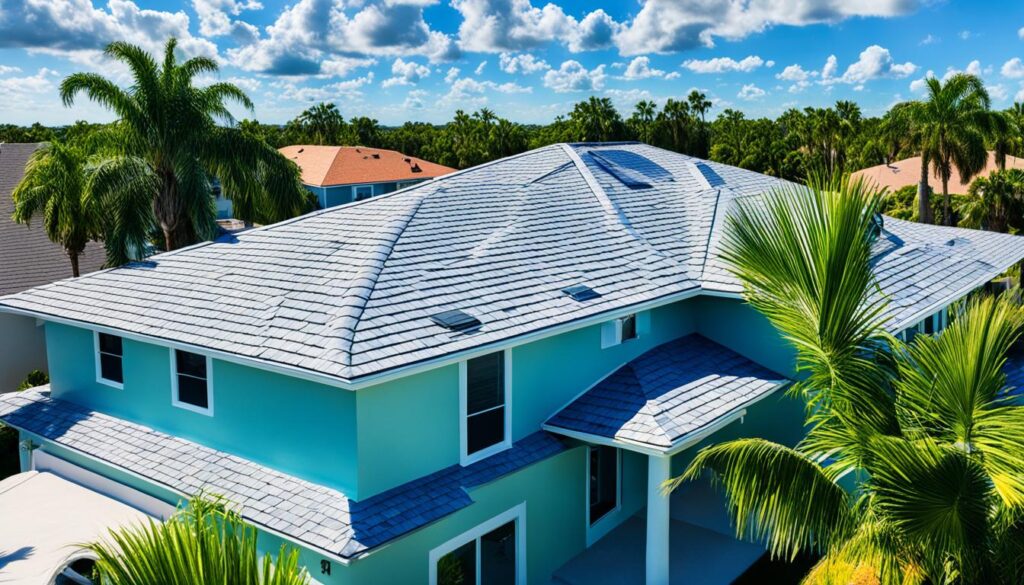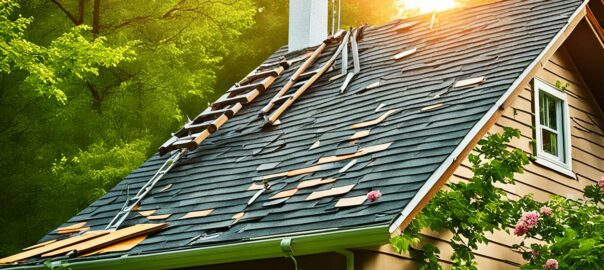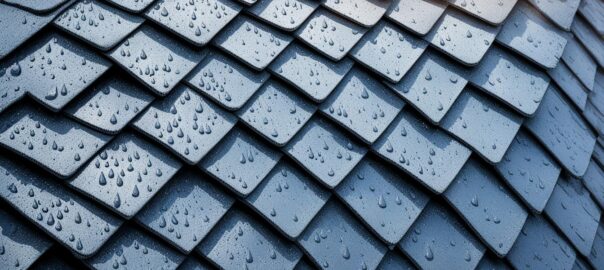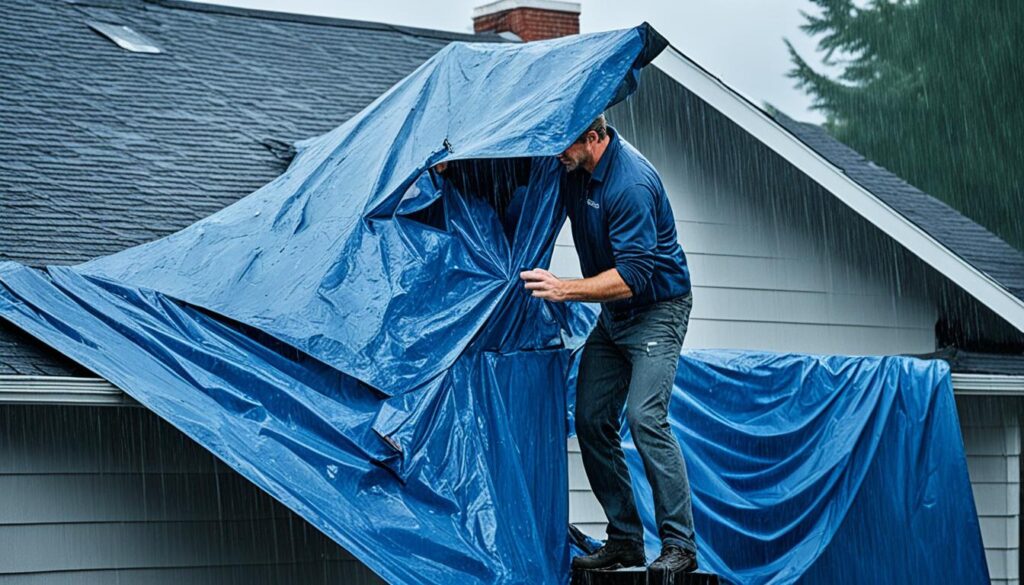Roof repairs should be timed just right. The season you pick for repair and replacement affects how long and well your roof holds up. It’s key to fix and maintain your roof when it’s best for the weather.
In the U.S., the top time for roof work shifts with where you live. Take Florida, for example. Winter and spring are the best times to fix roofs there. This is because there are fewer big storms. So, you’re less likely to face delays or need quick fixes.
Winter has cool weather perfect for roof work. This makes it easier to put on a new roof. Choosing the right time can really extend your roof’s life and strength.
Good advice and regular check-ups keep your roof strong. Check and fix problems early to stop them from getting worse. This saves you from big, expensive fixes later.
Should you be in Florida or elsewhere, picking the right season for repairs is crucial. It boosts your roof’s staying power and efficiency. So, plan well and enjoy a worry-free roof for many years.
The Best Time for Roof Repairs in Florida
The best time for roof work in Florida is winter or spring. These seasons have less stormy weather. This means work goes smoother without so many delays.
Winter also brings cooler temps, making work more comfortable. Fewer customers mean roofers can finish your job sooner too.
The type of roof you have affects its lifespan. Shingle roofs, for example, last 15 to 30 years. Metal roofs can hold up for 30 to 70 years, and tile roofs longest, possibly over 100 years.
High heat and sunlight can wear out roofs faster in Florida. Metal roofs are a great choice because they cope well with Florida’s weather. Tile roofs are the best for lasting a long time and fighting off fire, bugs, and decay.
Signs You Need a New Roof in Florida
If you’re in Florida, knowing when your roof needs replacing is key. Watch for signs like damaged shingles to fix roof problems early. This helps protect your home from more severe issues.
Missing or Damaged Shingles
Missing or damaged shingles stand out as clear signs your roof might be in trouble. If not fixed, they expose your roof to water damage. Acting fast when you see this can save you from bigger headaches later.
Granule Loss and Shingle Deterioration
Seeing lots of granules from your shingles in the gutters is a sign. So is finding shingles that are blistered, buckled, or curling. These issues weaken your roof against weather, stressing the need for a quick fix.
Water Stains
Water stains inside mean a roof leak might be above you. This leak could stem from various roof issues. Quick action to fix this or get a new roof can stop more home damage.
Sagging or Bowing Roof
If your roof looks like it’s sagging or bowing, contact a pro immediately. This could point to major structural trouble. It’s crucial to fix this fast by considering a new roof, ensuring your home’s safety.
High Energy Bills
Noticing your energy bills going up might mean your roof needs work. Old or poor insulation lets seasonal temperatures affect your bill. A new roof can help cut your costs by improving how your home holds in heat or cool.
Regular roof check-ups, maintenance, and quick fixes are a must in Florida. Being proactive by knowing and addressing these signs early can protect your home and lengthen your roof’s life.

The Average Cost of a Florida Roof
When you need to replace a roof in Florida, the cost varies. The main thing that affects the price is the time of year. Spring is the busiest time for roofing contractors. This may mean higher costs and a longer wait. But, choosing a quieter season could lead to better prices and less wait time.
If you wait for the off-season to replace your roof, you might get done faster. This can really help if you need a new roof right away or if you want the project finished in a short time.
Always get several quotes from different roofing companies. Don’t just look at the price – also check who offers quality installation. The cost shouldn’t be your only focus. You need to pick a company that is trusted and offers top materials, skillful work, and great customer service.
How Long Does It Take to Reroof a House?
Reroofing a house can take about three to four days. This time frame can change based on the roof’s size, pitch, and other factors. The process includes many steps that need to be done carefully.
The roof’s pitch and size greatly affect how long it takes to reroof. Steep roofs with a high pitch need more safety measures. They also take longer to finish. The size of the roof affects the project time as well. A bigger roof means more work and more time needed.
The weather is a big player in the roof replacement timeline. Rain, wind, or extreme temperatures can cause delays. This might force the roofing team to reschedule. They might also need to take more safety measures to protect themselves.
The roof material also impacts the time needed for reroofing. Each material has different installation methods. For instance, laying asphalt shingles is quicker than setting up metal or tile roofs.
A good roofing contractor will give you a date when they expect to be done. They will consider all these important factors before they start. This helps you know what to expect and plan for the project time.
Considering your roof’s features, the weather, the materials used, and talking to your contractor can make reroofing go smoothly. It helps the work get done in an efficient and timely manner.
How Does Weather Affect the Roofing Process?
Weather is a big deal in Florida’s roofing work. Winter snows don’t happen here, but storms and hurricanes do during summer and fall. These storms can delay roof work and harm new roofs before they’re ready.
The right temperatures matter for roof jobs. Some materials, like shingles, need warmth to stick well. Below 40 degrees Fahrenheit is too cold for shingles to bond correctly. This cold can affect the roof’s quality.
Florida’s summer heat also affects roofing. Shingles can get too soft and easily break in direct sunlight. Planning installations in cooler weather can prevent these problems. This approach helps the new roof last longer.
For a successful roof replacement here, knowing the weather is crucial. Working with local experts helps. They choose the best times to work on your roof. This advice safeguards your investment.
For help deciding when to replace your roof in Florida, check this guide.
How to Choose a Roofing Company?
Picking the right roofing company is key to a good roof job. It matters whether it’s the busy or slow season. Keep some key points in mind to get top-notch work without overpaying.
- Roofing companies are super busy during the high-demand times. This means you might wait longer for your roof to get fixed. Also, they might place more important jobs first. So, your work might take longer to start.
- But, the off-season means fewer people wanting their roofs done. This is your chance to compare prices and quality. It lets you choose carefully and pick the best fit for you.
- If you schedule when roofing companies are less busy, you might get perks. Your favorite roofer is more likely ready to start when you are. You might also score a deal, as some companies lower their prices to get projects in the quiet times.
How Long Will You Have to Wait for Roof Installation to Begin?
Roof installation time can change because of many reasons. One reason is the time of year. Summer and fall are very busy times. This makes the wait longer. But, if you pick winter or spring, you might have to wait less. This is because there’s not as much work then.
Hurricane season and bad weather can make things even longer. In late summer and early fall, many roofers might be busy with repairs from storms. This could mean they have less time for new roofs. Bad weather, like heavy rain and wind, can also slow things down. Very high temperatures make installing some roofs hard. These roofs need just the right weather to go on right.
Planning your roof work is key. If you want it done fast, go for the slow times. But, if you have to use certain materials, talk with your roofer. They can help things go without a hitch.
So, think about the wait, the outside things, and what you need. With some smart planning, you can start your roof work soon.
How to Avoid Roof Damage During Roof Installations in Florida
To make sure your roof installation in Florida goes smoothly, picking the right time matters a lot. The Florida weather is known for being unpredictable, making roof work risky during the hurricane season. These big storms can harm a roof that’s not yet fully installed. This might lead to leaks and more damage to your home.
Florida’s summer heat is also a challenge. It can make shingles soft, which is bad for a roofing job. Soft shingles might get damaged easily and won’t protect your home well.
So, it’s very important to choose your roof replacement time wisely. Stay away from the hurricane season. Pick a time when the weather is calm. This will protect your roof and your home. Make sure to hire a roofing company that knows how to work around the weather. They will give you the best advice. This way, you reduce the risk of roof damage and enjoy a long-lasting new roof in Florida.
Conclusion
In Florida, the right timing for roof work is key. Winter and spring are ideal for roof replacements. This is because the weather is usually calmer then. You can avoid work delays because of storms or the need for quick fixes.
Keeping your roof in good shape needs regular checks and fixes. Addressing small problems early can prevent bigger ones later. Plus, it helps your roof last longer and work better.
Being smart about costs, time needed for work, and the weather is important. Picking the best roofing company is crucial too. Choosing a quiet time of the year for your project can save money and time. Do your homework and find a trustworthy roofing business. Careful planning and working with the right experts lead to a successful roofing project in Florida.


